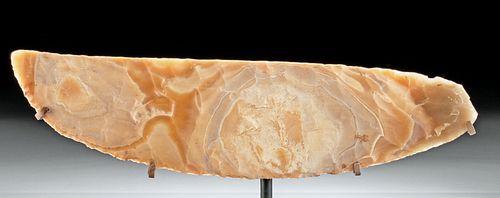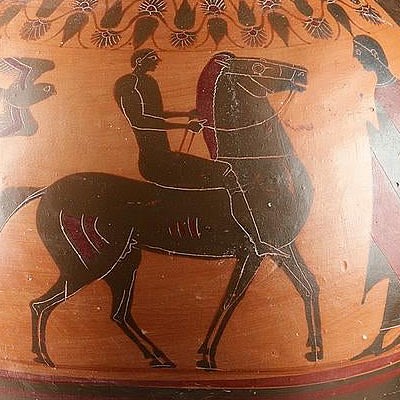Huge Egyptian Pre-Dynastic Naqada III Flint Knife Blade
Lot 2a
About Seller
Artemis Fine Arts
686 S Taylor Ave, Ste 106
Louisville, CO 80027
United States
Selling antiquities, ancient and ethnographic art online since 1993, Artemis Gallery specializes in Classical Antiquities (Egyptian, Greek, Roman, Near Eastern), Asian, Pre-Columbian, African / Tribal / Oceanographic art. Our extensive inventory includes pottery, stone, metal, wood, glass and textil...Read more
Estimate:
$3,500 - $4,500
Absentee vs Live bid
Two ways to bid:
- Leave a max absentee bid and the platform will bid on your behalf up to your maximum bid during the live auction.
- Bid live during the auction and your bids will be submitted real-time to the auctioneer.
Bid Increments
| Price | Bid Increment |
|---|---|
| $0 | $25 |
| $300 | $50 |
| $1,000 | $100 |
| $2,000 | $250 |
| $5,000 | $500 |
| $10,000 | $1,000 |
| $20,000 | $2,500 |
| $50,000 | $5,000 |
| $100,000 | $10,000 |
| $200,000 | $20,000 |
About Auction
By Artemis Fine Arts
Jun 4, 2020
Set Reminder
2020-06-04 10:00:00
2020-06-04 10:00:00
America/New_York
Bidsquare
Bidsquare : Exceptional Antiquities, Asian, Ethnographic
https://www.bidsquare.com/auctions/artemis-gallery/exceptional-antiquities-asian-ethnographic-5185
An important one-day auction featuring museum-worthy examples of Egyptian, Greek, Roman, Etruscan, Near Eastern, Far East / Asian, Pre-Columbian, African / Tribal, Oceanic, Native American, Spanish Colonial, Russian, Fossils, Ancient Jewelry, Fine Art, so much more! Artemis Fine Arts info@artemisfinearts.com
An important one-day auction featuring museum-worthy examples of Egyptian, Greek, Roman, Etruscan, Near Eastern, Far East / Asian, Pre-Columbian, African / Tribal, Oceanic, Native American, Spanish Colonial, Russian, Fossils, Ancient Jewelry, Fine Art, so much more! Artemis Fine Arts info@artemisfinearts.com
- Lot Description
Ancient Egypt, Pre-Dynastic Period, Naqada III, ca. 3200 to 3000 BCE. An exquisite example of a lengthy knife blade meant as a hand tool or to be used as a short scythe on the end of a wooden rod. The bifacial tool was shaped via the percussion flaking method which is made evident by the rough serrations along the curved blade edge, and a finer, softer style of knapping was used to create a smoother, more uniform blade edge along the straight side. Both faces exhibit naturally smooth surfaces, and the mottled hues of caramel, grey, tan, wheat, citrine, and coffee create for a sublime presentation. Size: 9.8" L x 2.4" W (24.9 cm x 6.1 cm); 3.9" H (9.9 cm) on included custom stand.
A strikingly similar example, of a smaller size, hammered for GBP 25,000 ($32,775.88) at Christie's, London "Antiquities" auction (sale 10372, April 15, 2015, lot 1).
Another stylistically similar example, of a slightly larger size, hammered for $80,500 at Christie's, New York "Antiquities" auction (sale 2565, June 8, 2012, lot 1).
Provenance: private East Coast, USA collection, acquired in the 2000s; ex-private European collection, acquired in the 1970s
All items legal to buy/sell under U.S. Statute covering cultural patrimony Code 2600, CHAPTER 14, and are guaranteed to be as described or your money back.
A Certificate of Authenticity will accompany all winning bids.
We ship worldwide and handle all shipping in-house for your convenience.
#152861Minor nicks and abrasions along edges and both faces commensurate with age and the knapping process, with scattered areas of light encrustations, otherwise intact and choice. Smooth patina and light earthen deposits throughout.Condition
- Shipping Info
-
All shipping is handled in-house for your convenience. Your invoice from Artemis Gallery will include shipping calculation instructions. If in doubt, please inquire BEFORE bidding for estimated shipping costs for individual items.
-
- Buyer's Premium



 EUR
EUR CAD
CAD AUD
AUD GBP
GBP MXN
MXN HKD
HKD CNY
CNY MYR
MYR SEK
SEK SGD
SGD CHF
CHF THB
THB














